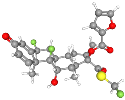| name | Fluticasone Propionate Cream |
| classification | Topical corticosteroid |
| pharmacokinetics | Fluticasone propionate is a potent corticosteroid primarily applied topically. It has low systemic absorption, meaning minimal effects elsewhere in the body. Metabolism primarily occurs in the liver. Individual variability in absorption and metabolism exists due to factors like application site and extent. |
| suggested dosage | Dosage varies depending on the condition and patient response. A typical starting dose involves a thin layer applied 1-2 times daily to the affected area. Consult a physician for personalized dosage recommendations. |
| indications | Topical treatment of inflammatory skin conditions like eczema, contact dermatitis, and psoriasis-related skin reactions. |
| safety in pregnancy | Limited data available. Topical use is likely to have minimal systemic effects, but consult a healthcare professional before use during pregnancy. Potential risks to the fetus must be weighed against treatment benefits. |
| safety in breastfeeding | Limited data. Low systemic absorption suggests minimal risk to the nursing infant, but consultation with a healthcare professional is essential. |
| side effects | | 1 | Skin irritation | | 2 | Burning sensation | | 3 | Skin dryness | | 4 | Skin thinning (atrophy) with prolonged use | | 5 | Striae (stretch marks) | | 6 | Acneiform eruptions | | 7 | Local skin infections (if skin barrier is compromised) |
|
| alternatives | |
| contraindications | Hypersensitivity to fluticasone propionate or inactive ingredients. Avoid application to broken or infected skin. |
| interactions | No significant known interactions with other drugs or supplements for topical use. Concurrent use with other topical corticosteroids might increase side effects. Discuss all medications with your doctor. |
| warnings and precautions | | 1 | Avoid use near eyes, nose, or mouth. | | 2 | Do not use on large areas of skin. | | 3 | Discontinue if irritation worsens. | | 4 | Consult a physician if symptoms persist or worsen. | | 5 | Patients with a history of skin conditions or taking other medications should consult a doctor before use. |
|
| additional information | | 1 | Apply a thin layer to affected area, avoiding contact with eyes. | | 2 | Clean the area before application. | | 3 | Cover the area if needed. | | 4 | Dosage is influenced by patient-specific factors (age, weight, other medical conditions). Always consult your prescribing physician. |
|
| important disclaimer | This information is for educational purposes only and does not constitute medical advice. Always consult a qualified healthcare professional for diagnosis and treatment. |

